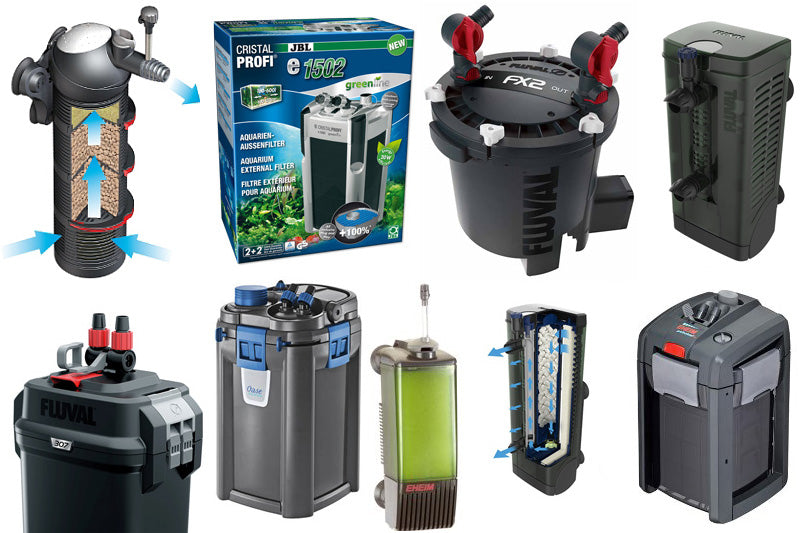
The filter is the life support of the aquarium and choosing the right type and size for your aquarium is important to maintaining good water quality and therefore healthy fish.
There are many types of filter available, the most popular being internal power filters and external canister filters. Some commercial tank kits may include one of these filter types. Other types of filter may be appropriate in some situations, such as air-powered sponge or box filters, undergravel filters or sump filter systems.
Internal filters
For small to medium tanks, internal power filters are the most popular choice. In larger tanks, more than one can be used, or they can be combined with an external canister filter. Whichever brand you use, make sure the filter is rated for the size of your tank, or preferably slightly larger, to allow some leeway.
At Wharf Aquatics we stock the leading brands of internal filters, including Fluval U Filters, Eheim Aquaball and Biopower filters.

Internal power filters normally use sponge/foam media. This strains out particles and physical debris (referred to as mechanical filtration), but also acts biologically once the filter has matured (i.e. a sufficient number of the good bacteria that break down wastes have built up).
Once the sponge has biologically "matured", it should be preserved by rinsing the sponge lightly in water from the aquarium to remove obvious sludge. Never clean the sponge in hot or chlorinated tap water, as this will kill off the essential bacteria.
The sponge only needs replacing when it becomes permanently clogged, misshapen or deteriorated. Most leading brands of internal filter have more than one sponge, so they can be replaced at different times (at least a couple of weeks apart) so that the filtration bacteria are not all lost.
Some filters also incorporate polyester filter pads for removing fine particles, carbon pads for removing discolouration and organic wastes and possibly additional biological media with a high surface area for the growth of filter bacteria.
External filters
For larger tanks, external canister filters are the most popular choice. They are usually designed for aquariums of 100 litres (22 UK gal) or more, and some larger models are suitable for aquariums of more than 1000 litres (220 gal).
External canister filters are placed below the tank and connected via intake and output tubes. They need to be primed before use, and most newer types incorporate some sort of auto-priming device.
Here at Wharf we stock the leading brands of external canister filters, including Fluval 07 and FX series, Eheim Professional filters, JBL CristalProfi filters and Oase Biomaster filters.

Canister filters have a larger capacity. This gives plenty of room for biological media, and also the flexibility to use other types of media, such as carbon, peat or resins to adsorb phosphates or nitrates.
As with internal filters, you should choose a model appropriate to the size of your tank, and preferably one designed for a slightly larger tank, to err on the safe side - especially if the aquarium will be well stocked, or contain large or messy fish. In this case, we recommend you choose a filter at least 50% larger than normally recommended, e.g. for a 200 L tank, choose a filter rated for a 300 L aquarium.
For many medium to larger setups, the combination of an internal and external filter is ideal.
Summary
External filters provide a large capacity and flexibility for media, and do not need cleaning as often (typically every 2-3 months or more for an average fish load). Internal filters do not have such a large capacity, and need cleaning about every 2 weeks or so; however, they are simple to install and maintain and they are efficient at removing particles from the water and providing extra circulation and aeration.

